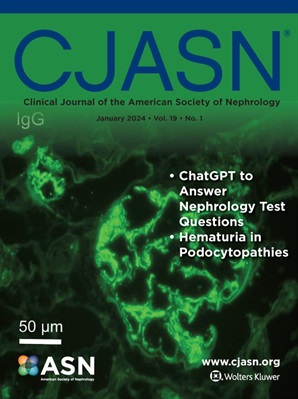Sudden Cardiac Death Reporting in US Dialysis Patients: Comparison of USRDS and National Death Index Data.
IF 8.5
1区 医学
Q1 UROLOGY & NEPHROLOGY
Clinical Journal of the American Society of Nephrology
Pub Date : 2024-10-15
DOI:10.2215/cjn.0000000000000560
引用次数: 0
Abstract
BACKGROUND Cause-specific mortality data from the United States Renal Data System (USRDS) form the basis for identifying cardiovascular disease (CVD), specifically sudden cardiac death (SCD), as the leading cause of death for patients on dialysis. Death certificate data from the National Death Index (NDI) is the epidemiological standard for assessing causes of death for the United States population. The cause of death has not been compared between the USRDS and the NDI. METHODS Among 39,507 adults starting dialysis in the US, we identified 6436 patients who died between 2003-2009. We classified the cause of death as SCD, non-SCD CVD, cancer, infection, and others; and compared the USRDS to the NDI. RESULTS Median age at the time of death was 70 years, 44% were female, and 30% were non-Hispanic Black individuals. The median time from dialysis initiation to death was 1.2 years. Most deaths occurred in-hospital (N=4681, 73%). The overall concordance in cause of death between the two national registries was 42% (κ=0.23, 95% confidence interval 0.22 to 0.24). CVD, including SCD and non-SCD CVD, accounted for 67% of deaths per the USRDS but only 52% per the NDI; this difference was mainly driven by the larger proportion of SCD in the USRDS (42%) versus the NDI (22%). Of the 2962 deaths reported as SCD by the USRDS, only 35% were also classified as SCD by the NDI. Out-of-hospital deaths were more likely to be classified as SCD in the USRDS (60%) versus the NDI (29%), compared to in-hospital deaths (41% in the USRDS; 25% in the NDI). CONCLUSIONS Significant discordance exists in the causes of death for patients on dialysis reported by the USRDS and the NDI. Our findings underscore the urgent need to integrate NDI data into the USRDS registry and enhance the accuracy of cause-of-death reporting.美国透析患者的心脏性猝死报告:美国透析患者心脏性猝死报告:美国透析患者心脏性猝死报告与全国死亡指数数据的比较。
背景美国肾脏数据系统(USRDS)提供的特定死因数据是确定心血管疾病(CVD),特别是心脏性猝死(SCD)是透析患者主要死因的依据。全国死亡指数(NDI)中的死亡证明数据是评估美国人口死亡原因的流行病学标准。在美国开始透析的 39,507 名成年人中,我们发现了 6436 名在 2003-2009 年间死亡的患者。我们将死因分为 SCD、非 SCD 心血管疾病、癌症、感染和其他,并将 USRDS 与 NDI 进行了比较。结果死亡时的平均年龄为 70 岁,44% 为女性,30% 为非西班牙裔黑人。从开始透析到死亡的中位时间为 1.2 年。大多数死亡发生在医院内(4681 例,73%)。两个国家登记处的死因总体一致率为 42%(κ=0.23,95% 置信区间为 0.22 至 0.24)。心血管疾病(包括 SCD 和非 SCD 心血管疾病)占 USRDS 死亡人数的 67%,但仅占 NDI 死亡人数的 52%;造成这一差异的主要原因是 USRDS 中 SCD 的比例(42%)高于 NDI(22%)。在 USRDS 报告的 2962 例 SCD 死亡中,只有 35% 在 NDI 中也被归类为 SCD。与院内死亡(USRDS 为 41%;NDI 为 25%)相比,院外死亡在 USRDS(60%)和 NDI(29%)中更有可能被归类为 SCD。我们的发现强调了将 NDI 数据纳入 USRDS 登记册并提高死因报告准确性的迫切需要。
本文章由计算机程序翻译,如有差异,请以英文原文为准。
求助全文
约1分钟内获得全文
求助全文
来源期刊
CiteScore
12.20
自引率
3.10%
发文量
514
审稿时长
3-6 weeks
期刊介绍:
The Clinical Journal of the American Society of Nephrology strives to establish itself as the foremost authority in communicating and influencing advances in clinical nephrology by (1) swiftly and effectively disseminating pivotal developments in clinical and translational research in nephrology, encompassing innovations in research methods and care delivery; (2) providing context for these advances in relation to future research directions and patient care; and (3) becoming a key voice on issues with potential implications for the clinical practice of nephrology, particularly within the United States. Original manuscript topics cover a range of areas, including Acid/Base and Electrolyte Disorders, Acute Kidney Injury and ICU Nephrology, Chronic Kidney Disease, Clinical Nephrology, Cystic Kidney Disease, Diabetes and the Kidney, Genetics, Geriatric and Palliative Nephrology, Glomerular and Tubulointerstitial Diseases, Hypertension, Maintenance Dialysis, Mineral Metabolism, Nephrolithiasis, and Transplantation.

 求助内容:
求助内容: 应助结果提醒方式:
应助结果提醒方式:


